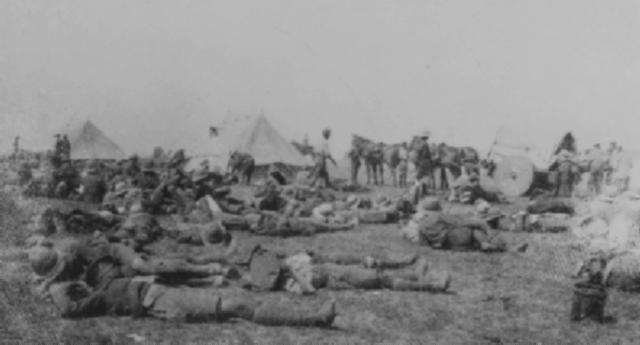Topic: BatzP - 1st Gaza
The First Battle of Gaza
Palestine, 26 to 27 March 1917
Outline

First Gaza, fought on 26-27 March. 1917, was the first British attempt to capture the major Turkish centre lying 32 kilometres inside the border of Palestine having captured Rafa (q.v.) at the start of the year and subsequently cleared out the remaining garrisons of Turks within Sinai, the British were now ready to strike deep into the enemy's own territory. Available for this operation were three British infantry divisions, two mounted divisions and a Camel brigade - a total of about 22,000 men. Each of the mounted divisions contained two Australian light horse brigades, comprising half their strength; the Anzac Mounted Division was under the command of Major-General Larry Chauvel, the Imperial Mounted Division under a British officer, Major-General Henry Hodgson.

In the pre-dawn hours of 26 March, Chauvel's division led off the march from the attacking force's advanced base around Deir el Belah, some sixteen kilometres southwest of Gaza. Its route took it ten kilometres east of the town, then west towards the Mediterranean, so that the Anzac Mounted was effectively astride the enemy's rear and able to join in the assault From both north and east. Hodgson's division, with the Camel Brigade and a New Zealand armoured car patrol also moved out onto the eastern flank, to prevent any attempt at reinforcement of the enemy garrison (thought to number about 4,000) from that quarter. With Gaza thus cut off, the 53rd Infantry Division - supported by the 54th Division - moved up on the town's southern approaches to complete its encirclement.
Delays experienced by the infantry due to unseasonal fog meant that it was nearly noon before the attack began, and nearly sunset before the heights of Ali Muntar which commanded the town from the southeast were in British hands. Meanwhile the men of Chauvel's division had captured other high ground to the north and were pressing on the town's outskirts. Even though the enemy's resistance was clearly crumbling, the failure to have achieved a decisive success before nightfall prompted the British high command to call off the assault, as had happened at Magdhaba (q.v.) and Rafa, for fear of the mounted troops being left without water. With the discovery that the Gaza garrison was larger than believed, and several large columns of Turkish reinforcements - one reported as 3,000 strong-sighted approaching from the north-east, east and south-east, the order for Chauvel and Hodgson's divisions to withdraw was given at about 6 p.m.

Although some of the mounted troops had already penetrated into the town's northern and eastern streets, this time there was no question of defying the recall order. Chauvel himself protested, but for his men there was nothing to do but shoulder their dismay and disgust at being Forced to surrender a victory which they considered had already been won. After collecting their wounded and some of their dead, they come away in the darkness without any hostile follow-up by the enemy, bringing with them over 460 prisoners and two captured guns. Even the reinforcements which had earlier seemed so threatening on the flanks were held off with ease.
The British infantry maintained their positions on Gaza's southern outskirts for the night, but vacated the Ali Muntar heights. Ordered to re-occupy (his position the next morning, the infantry initially found it unoccupied by the enemy but were unable to properly secure it before the Turks forced them off again. They, too, were withdrawn by dawn on 28 March, finally confirming the failure of the coup de main against Gaza essentially due to a command fiasco. The attempt had cost the British nearly 4,000 casualties, 3,000 of these in the infantry; the Turks had lost perhaps 2,500.

Extracted from the book produced by Chris Coulthard-Clark, Where Australians Fought - The Encyclopaedia of Australia's Battles, Allen and Unwin, Sydney, 1998, pp. 124-125.
Additional References cited by Chris Coulthard-Clark:
H.S. Gullett, (1944), The Australian Imperial Force in Sinai and Palestine, Sydney: Angus & Robertson.
A.J. Hill, (1978), Chauvel of the Light Horse, Carlton, Vic.: Melbourne University Press.
Further Reading:
The First Battle of Gaza, Palestine, 26 to 27 March 1917
The First Battle of Gaza, Palestine, 26 to 27 March 1917, Allied Forces, Roll of Honour
The Palestine Campaign, 1917 - 1918
Battles where Australians fought, 1899-1920
Citation: The First Battle of Gaza, Palestine, 26 to 27 March 1917, Outline



